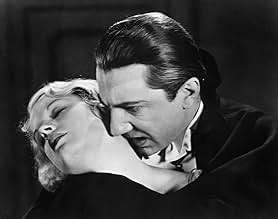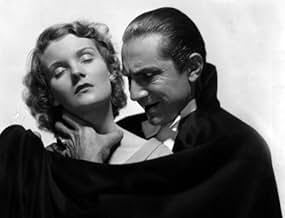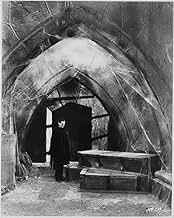VALUTAZIONE IMDb
7,3/10
62.484
LA TUA VALUTAZIONE
Dopo che un ingenuo agente immobiliare soccombe alla volontà del conte Dracula, i due si dirigono a Londra dove il vampiro dorme nella sua bara di giorno e cerca potenziali vittime di notte.Dopo che un ingenuo agente immobiliare soccombe alla volontà del conte Dracula, i due si dirigono a Londra dove il vampiro dorme nella sua bara di giorno e cerca potenziali vittime di notte.Dopo che un ingenuo agente immobiliare soccombe alla volontà del conte Dracula, i due si dirigono a Londra dove il vampiro dorme nella sua bara di giorno e cerca potenziali vittime di notte.
- Regia
- Sceneggiatura
- Star
- Premi
- 5 vittorie e 3 candidature totali
Charles K. Gerrard
- Martin
- (as Charles Gerrard)
Anna Bakacs
- Innkeeper's Daughter
- (non citato nei titoli originali)
Bunny Beatty
- Flower Girl
- (non citato nei titoli originali)
Nicholas Bela
- Coach Passenger
- (non citato nei titoli originali)
Daisy Belmore
- Coach Passenger
- (non citato nei titoli originali)
William A. Boardway
- Concertgoer Outside Theatre
- (non citato nei titoli originali)
Barbara Bozoky
- Innkeeper's Wife
- (non citato nei titoli originali)
Tod Browning
- Harbormaster
- (voce)
- (non citato nei titoli originali)
Moon Carroll
- Maid
- (non citato nei titoli originali)
Geraldine Dvorak
- Dracula's Wife
- (non citato nei titoli originali)
Recensioni in evidenza
"I bid you welcome," "I never drink wine," "Children of the night...what music they make," and of course "I am Dracula" are memorable lines that resonate throughout horror films, literature, art, etc... throughout the 20th century because of a landmark film made in 1931 starring Bela Lugosi and directed by Tom Browning. This film was the birth of the horror film as we know it. Its importance can not be underestimated. Dracula is a wonderful film for so many reasons, but first let's look at its many faults.
The film is by today standards very antiquated. It has almost no soundtrack, stage acting for the most part, limited special effects, and a slow pacing. It has long parts of little action and lots of chat. It shows little while leaving much to one's imagination(a plus for those like myself that are good at envisioning what is not shown). With all this not going for it, why is Dracula such a classic? Why is it considered to be such a great film and a great horror film?
The answer is that even with all these flaws (and bear in mind some of these flaws are not flaws for all) the film offers a rich story in an eerie, atmospheric way. Bela Lugosi was Dracula. He was the model for oh so many vampires to come. His gesturing, his deliberation in speech, his facial movements all created a vampire never to be forgotten. Despite Lugosi, however, is the real genius of the film....Tod Browning. Browning created a movie and a setting hitherto imagined and conjured on a screen. Browning was the man behind the camera that created the cob-webbed stairs of the Dracula castle and the squalid emptiness of the crypt. He created the ghoulish female vampires thirsting for blood. Dracula is not just a film to see, it is film history and should be viewed with that in mind and not put under a microscope of today's languishing tastes.
The film is by today standards very antiquated. It has almost no soundtrack, stage acting for the most part, limited special effects, and a slow pacing. It has long parts of little action and lots of chat. It shows little while leaving much to one's imagination(a plus for those like myself that are good at envisioning what is not shown). With all this not going for it, why is Dracula such a classic? Why is it considered to be such a great film and a great horror film?
The answer is that even with all these flaws (and bear in mind some of these flaws are not flaws for all) the film offers a rich story in an eerie, atmospheric way. Bela Lugosi was Dracula. He was the model for oh so many vampires to come. His gesturing, his deliberation in speech, his facial movements all created a vampire never to be forgotten. Despite Lugosi, however, is the real genius of the film....Tod Browning. Browning created a movie and a setting hitherto imagined and conjured on a screen. Browning was the man behind the camera that created the cob-webbed stairs of the Dracula castle and the squalid emptiness of the crypt. He created the ghoulish female vampires thirsting for blood. Dracula is not just a film to see, it is film history and should be viewed with that in mind and not put under a microscope of today's languishing tastes.
It's almost impossible not to love 'Dracula', a horror milestone that is the most important and influential vampire movie ever made. Bela Lugosi became a cinematic legend after this movie, and his portrayal of Dracula basically invented the modern vampire as we know it. Murnau's silent classic 'Nosferatu' was an obvious influence on Todd Browning, but while Browning was no James Whale (the innovative British director who made 'Frankenstein' for Universal a few months after this) he added a lot of his own style and ideas to the project, and Counts Orloff and Dracula are completely different kinds of creatures. Lugosi made his Count sophisticated, attractive and sexy, and this is what made this movie such a sensation at the time, and what helps make it still a wonderful viewing experience. Lugosi's performance is one of the greatest in horror history. Some of the other actors in the cast are a bit shaky but Edward Van Sloan as Van Hesling is excellent and Dwight Frye's Renfield (a different character from the book) is also memorable. Both actors would reappear in 'Frankenstein'. 'Dracula' is an important landmark horror movie, but even better, is still a fantastic viewing experience seventy years later. Don't just watch it because it's a classic, watch it because it's wonderful entertainment!
This is the movie that set the horror genre into action. Sure there may be a few campy scenes that look like they might be out of some high school play production (the rubber bats and armadillos in Dracula's castle come to mind), but there is an unmistakable suspense and eerieness about the film. If you are lucky enough to find the DVD reissue from 1999, you have three great versions: the original 1931 version with basically no background music, the 1999 rescoring of the movie by composer Philip Glass, and the extremely interesting Spanish version, made at the same time as the original (with totally different actors). If you have this DVD, watch the movie twice: once with no soundtrack and once with the Glass rescoring.... totally different movie. Glass' score is great, but it doesn't really help the movie at all (it actually hurts it in many cases). But the utter silence in Browning's original just makes my skin crawl! The acting is actually quite great (Lugosi is, of course, phenomenal as is Dwight Frye as Renfield). The fear, the suspense, and, believe it or not, the sexuality, combines for a great movie that was an unbelievable success in its first release ($700,000 in it first US release, $1.2 million worldwide). Not bad for a movie made 72 years ago!
While Tod Browning's Dracula is not the definitive take on the most famous vampire of all time, it is possibly the most memorable one. This is not due to Browning's technical achievements or directorial wizardry, by ANY means. It is due to Bela Lugosi's career-defining portrayal of the title character. Born in what is now Lugoj, Romania, Lugosi brings to the part the flavor of his homeland, making him more believable as Dracula. This other-worldly aesthetic helped to make his performance what many consider the ultimate incarnation of Stoker's Dracula. Having played the Count in Hamilton Deane's Broadway version of Dracula, which started in 1927, Bela Lugosi was more than prepared for the role when it was time to commit it to film. Still struggling with the English language, however, he had to learn his lines phonetically. European accent in tact, he was able to deliver such memorable lines as, "I bid you welcome," "Listen to them. Children of the night. What music they make," and, of course, "I am Dracula." His performance alone is reason enough to watch this monster movie classic. If only the rest of the film was as spectacular as Lugosi. Dwight Frye's Renfield, while perhaps a little too over-the-top, is still another highlight to the film, and even Edward Van Sloan's Van Helsing is enough to challenge the might of Count Dracula. The rest of the film is rather flat to me. Now, I know it was made in 1931, and that, at the time, it horrified audiences, but I still stand by my opinion that the overall movie pales in comparison to Bela Lugosi's performance. Everyone else just seemed to be going through the motions, and it seems especially evident while Helen Chandler and David Manners are on screen. They just aren't convincing. I'm not saying that their performances ruin the film. It is still a classic, and certainly worth a viewing, but if you are in the mood for a vampire movie that is worthy of Bram Stoker's name, look no further than F. W. Murnau's Nosferatu. It is much more convincing and even scarier than Tod Browning's Dracula, despite being nine years older and silent. All in all, though, one cannot overlook the stellar performance of Bela Lugosi in the role he was born to play!
Bela Lugosi forever captures the role of a certain undead Transylvanian count who takes a trip to London in the first legitimate version of the classic Bram Stoker novel. Despite many attempts by many talented film makers, I believe this version, directed by Tod Browning, remains the definitive take on the often-filmed novel. But why? Is it simply nostalgia? Granted, I do fondly remember staying up late as a child watching this film on Ghost Host theater and finding myself suitably frightened. However, if I were the same age today, would I find the film as effective? Would a steady diet of more modern and explicit horror films made me too jaded to enjoy the more subtle charms of this film? I hope not, but I could see how it might. The film is slow, and its slowness is further emphasized by the absence of an under score. It is stagey - being as it was more influenced by the stage play than the novel itself. Also, the story plays itself out too quickly. Van Helsing manages to figure everything out and dispatch the count in about two seconds. There simply isn't much suspense - and even less gore or violence. Yet it remains the champ. Why? The main reason is Lugosi himself. He gives the performance of a lifetime. He truly inhabits the role and is genuinely creepy. The rest of the cast, particularly Edward Van Sloan as Van Helsing and Dwight Frye as Renfield, support him admirably. However, when I watch the old Universal horror films nowadays, I find myself really enjoying the atmospheric sets and lighting. Yes, there is still much to love about Dracula today. (As long as you avoid the optional Philip Glass score on the DVD!)
Lo sapevi?
- QuizGenerally regarded as the film that kickstarted the horror genre in Hollywood.
- BlooperIn the scene where Van Helsing is attempting to catch Dracula's lack of reflection in a mirror, there are visible chalk marks on the floor showing Bela Lugosi where to stand for the shot.
- Citazioni
Count Dracula: This is very old wine. I hope you will like it.
Renfield: Aren't you drinking?
Count Dracula: I never drink... wine.
- Curiosità sui creditiThe original title card has producer Carl Laemmle, Jr. identified as Presient (sic).
- Versioni alternativeA version of the film played on the 10/24/15 airing of Svengoolie (1995) featured a soundtrack taken from the French language audio track on the Dracula Blu-ray.
- ConnessioniAlternate-language version of Drácula (1931)
- Colonne sonoreSwan Lake, Op.20
(1877) (uncredited)
Music by Pyotr Ilyich Tchaikovsky
Excerpt Played during the opening credits
I più visti
Accedi per valutare e creare un elenco di titoli salvati per ottenere consigli personalizzati
- How long is Dracula?Powered by Alexa
- What is 'Dracula' about?
- Is 'Dracula' based on a book?
- How does the movie end?
Dettagli
- Data di uscita
- Paese di origine
- Sito ufficiale
- Lingue
- Celebre anche come
- Dracula primo
- Luoghi delle riprese
- Azienda produttrice
- Vedi altri crediti dell’azienda su IMDbPro
Botteghino
- Budget
- 355.000 USD (previsto)
- Lordo in tutto il mondo
- 87.019 USD
- Tempo di esecuzione1 ora 15 minuti
- Proporzioni
- 1.20 : 1(original release)
Contribuisci a questa pagina
Suggerisci una modifica o aggiungi i contenuti mancanti



































